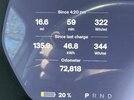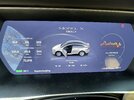A question for those who understand batteries and know where and how the car uses them. I'm trying to keep track of my battery consumption. And here is the latest data I have measured. Last time I charged the car at 100% (90 kW battery and yes - I know that charging at 100% is bad for me). After 6 days came to supercharger with 20% charge. All the data is shown in the photo. First pic before final charge and second after final charge. In 6 days the car drove 136 miles at an average consumption of 344 w/ml and used 46.8 kWh. That being said, I charged it again at 100% and the car took the charger 58 kWh.
I have the following questions:
1. Where did the 11 kW difference go? I'm in NYC. Temperature is 60-76F these days. Air conditioning has been on for maybe 2 hours. The rest of the time the climate is either off or fan only on. Total travel time was aprox 7 hours (traffic, traffic lights ect). For a natural discharge is also a bit much.
2. It turns out that at this consumption car will only drive 170 ml instead of 252 (I understand - it's city mileage, but the battery consumption is quite economical).
3. 58 kW charging from 20 to 100% does not give a total battery capacity of 90 kW. Does this mean that the battery capacity has dropped a lot or am I missing something?
Please do not share tips like "need to change the battery". All advice based on personal experience and knowledge would be welcome.
My car model X 90D 2016.
I have the following questions:
1. Where did the 11 kW difference go? I'm in NYC. Temperature is 60-76F these days. Air conditioning has been on for maybe 2 hours. The rest of the time the climate is either off or fan only on. Total travel time was aprox 7 hours (traffic, traffic lights ect). For a natural discharge is also a bit much.
2. It turns out that at this consumption car will only drive 170 ml instead of 252 (I understand - it's city mileage, but the battery consumption is quite economical).
3. 58 kW charging from 20 to 100% does not give a total battery capacity of 90 kW. Does this mean that the battery capacity has dropped a lot or am I missing something?
Please do not share tips like "need to change the battery". All advice based on personal experience and knowledge would be welcome.
My car model X 90D 2016.




